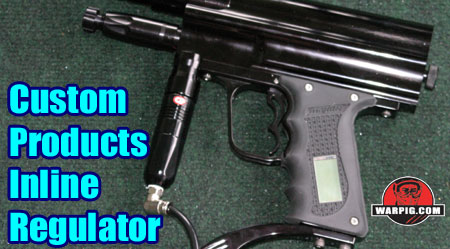  |
|
|
|
|
|
|
  |
|
|
|
|
|
|

What
do you think?
|

Custom Products Inline Reg March 2004 Since their introduction to paintball, inline regulators have thankfully, become smaller and lighter, as well as more efficient. Custom Products, a company which specializes in various aftermarket accessories, has thrown their hat into the inline regulator ring with the CP Inline Regulator. A regulator has a simple purpose, to allow gas out of a high pressure source as needed to maintain a lower pressure output. A common use for inline regulators in paintball is between a compressed air system that is feeding out 400 to 800 psi, and a paintgun that is expecting an input pressure of 200 to 300 psi. The regulator steps down the pressure. There’s more to a regulator than a pressure drop though. As gas is used by the paintgun, the regulator must react fast enough to re-supply the paintgun’s valve. If the regulator responds slowly, or has a restricted flow rate, the paintgun will not recharge quickly, and velocity will drop off during rapid fired strings. CP’s regulator has a compact, ergonomic design. It is constructed in three sections. The top section features ASA threading and an o-ring. This allows it to mount in a vertical ASA, such as on an Angel IR3, Autococker, Matrix or other paintgun. The vertical placement also allows the reg to act as a fore grip. Adorning the bottom of the first section are a pair of CP logo jewels. The interior of the first section is primarily an empty space, which acts as a reservoir for air on the low-pressure side.
The third segment of the regulator contains the regulator seal and its adjustment mechanism. Six teardrop shaped cuts in the body look decorative, but actually serve as wrench flats. When installing a macroline, elbow or other hose fitting to the regulator’s input port at the bottom, an adjustable wrench (lined with a shop rag to prevent scratches) can get a sure grip in the body’s flats. Placement of the input port at the bottom rather than the side, makes it easy to mount the regulator in a paintgun with gas fittings attached, with no conflict between the fittings and a trigger guard.
In the regulator’s bottom section a ring of seven holes bring gas up from the input to the regulator seal, the large number of holes is to prevent that gas path from becoming a flow bottleneck.
With the lower part of the regulator removed, the seal face, and the regulator seal itself are easily accessed for inspection and cleaning. The CP Inline Regulator reviewed was one of a number of upgrades performed by Generation E when upgrading a Slide Switch Matrix to an LCD. In the summer of 2003, Gen E adopted the CP reg as their standard for use with the Matrix, citing its consistency and high flow rates at lower pressures as the reason. On the field, driving the LCD bolt in the Matrix, the CP Inline regulator has performed without problem, and with no visible shoot down problems. It should be noted that the adjustment arrangement with the ball bearing changing pressure on the regulator seal means that adjustment is sensitive. Dialing in the pressure of the CP Inline Regulator is done in very small steps, with fractions of a turn, unlike most regulators in which the adjuster screw is linked directly to a spring driving pressure to the piston. In addition to the compact version of
the regulator reviewed, versions are available with a longer bottom section
featuring a recessed macroline fitting in the bottom, and an optional fitting
for an output pressure gauge.
|
| Copyright © 1992-2019
Corinthian Media Services. WARPIG's webmasters can be reached through our feedback form. All articles and images are copyrighted and may not be redistributed without the written permission of their original creators and Corinthian Media Services. The WARPIG paintball page is a collection of information and pointers to sources from around the internet and other locations. As such, Corinthian Media Services makes no claims to the trustworthiness or reliability of said information. The information contained in, and referenced by WARPIG, should not be used as a substitute for safety information from trained professionals in the paintball industry. |